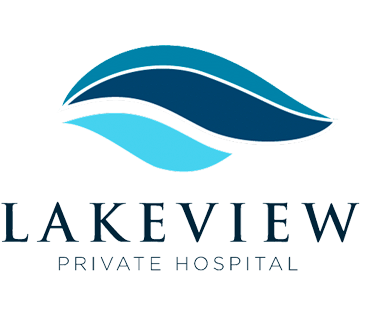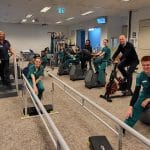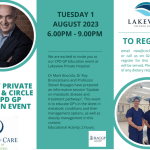Spotlight on Lakeview Private Hospital Surgeon
Dr Stening is an orthopaedic surgeon with a particular interest in anterior minimally invasive hip and computer assisted knee replacement surgery. After graduating, he completed fellowships in hip
and knee arthroplasty in Australia and in paediatric orthopaedics in the United States. Dr Stening has been in clinical practice since 1999, and is a founding doctor at Lakeview Private Hospital.
What attracted you to Lakeview Private Hospital?
I became interested in Lakeview Private Hospital after being involved with Castle Hill Day Surgery (CHDS) which, like Lakeview Private Hospital, is a doctor designed/operated facility. Of all the hospitals I had worked at, CHDS was more efficient and received more unsolicited positive feedback from my patients than any other hospital. When the opportunity arose to be part of Lakeview Private Hospital, I could see that the same philosophy applied and I did not hesitate to become involved. Lakeview Private Hospital has been designed from the ground up with patient care as the top priority. The whole patient experience is seamless – patients receive their consultations, investigations, surgery, inpatient rehab and outpatient services in the one friendly and modern facility.
Why should GPs be confident referring patients to Lakeview Private Hospital Orthopaedics?
Lakeview Private Hospital Orthopaedics is now the largest orthopaedic group practice in the country. All specialists are highly trained and experienced proceduralists covering most subspecialty disciplines. The combined expertise is exceptional and the group enjoys excellent comradery. Being on-site at Lakeview Private Hospital means patients of Lakeview Private Hospital Orthopaedics enjoy the benefits of a new facility.
What is the most satisfying part of your work?
Day after day I see patients who are living with chronic pain from hip and knee arthritis and common injuries. Their daily living is difficult and their enjoyment of life is very limited. Often chronic pain can lead to depression. Through orthopaedic surgery I see patients’ lives transformed. I perform several hundred hip and knee replacements annually and am proud to be instrumental in bringing quality of life back to these people.
Hip and knee replacement surgeries are your areas of interest. When is the right time for a GP to refer a patient for these types of surgeries?
Total hip and knee replacements are proven effective treatments for arthritis. Surgery can completely relieve patients’ pain, improve mobility and quality of life. As a general rule, GPs should refer patients if pain is fairly constant (particularly rest pain), is not being controlled with analgesia and/or anti- inflammatory medication, activity modification or joint rehabilitation exercises, and if the pain is interfering with activities of daily living. A plain X-ray, including a weight bearing film, is generally sufficient to confirm whether a patient has significant osteoarthritis.
What approach do you take to hip and knee replacement surgeries?
For my hip and knee replacements, I use pre- operative CT planning and 3D CT reconstruction to optimise implant sizing and positioning. This approach improves the longevity and function of the patient’s joint replacement. The majority of my hip replacements are also done using an anterior approach. I commenced doing this approach five years ago
and now act as a proctor for surgeons wishing to learn the technique. It is a true muscle sparing approach that is particularly advantageous for younger patients as it preserves muscle strength and secondarily stability of the joint.
ACL reconstructions represent a large part of your work. When should GPs refer patients for possible ACL surgery and what is involved?
I perform a large number of primary and revision ACL reconstructions in both adult and paediatric patients. The ACL is an important stabiliser for the knee. It is commonly injured playing sport and patients often describe a ‘popping’ sensation followed by a sudden onset of pain and swelling.
ACL injuries usually occur in adults, however, a greater number of children are suffering this injury because of impact sports. Treatment in children is more complex as they are still growing.
GPs should refer a patient when there are persistent symptoms of instability of the knee. Surgery is not always necessary. Some people can compensate quite well, however, patients who want to remain active generally require surgical reconstruction. Surgery is performed arthroscopically and hamstring or patella tendon is harvested to replace the torn ACL.
In paediatric patients other methods may be needed.
ACL reconstructions are often combined with meniscal surgery but can also be protective of future meniscal injury and subsequent progressive knee arthritis.
ACL reconstruction is a common procedure. In the hands of an experienced surgeon, up to 95 per cent of patients have very good results. There are risks associated that we need to be aware of but of course
I monitor all my patients closely post operatively to assess for any complications.
How important is rehab post operatively?
Rehabilitation is an extremely important part of the recovery process; helping
to restore movement, build muscle strength and improve circulation. One of the great aspects of Lakeview Private Hospital is the state- of-the-art rehabilitation facility which offers
speciality orthopaedic and reconditioning inpatient and outpatient services. Patients benefit from the hydrotherapy pool, fully equipped gyms, and ongoing lifestyle and wellness programs provided by the skilled multidisciplinary team.
For more information on
Dr Stening visit www.drmichaelstening.com.au or phone 02 8711 0109.
For information on Lakeview Private Hospital Orthopaedics visit www.hssortho.com.au.
Article featured in Lakeview Private Hospital News – Autumn 2016





